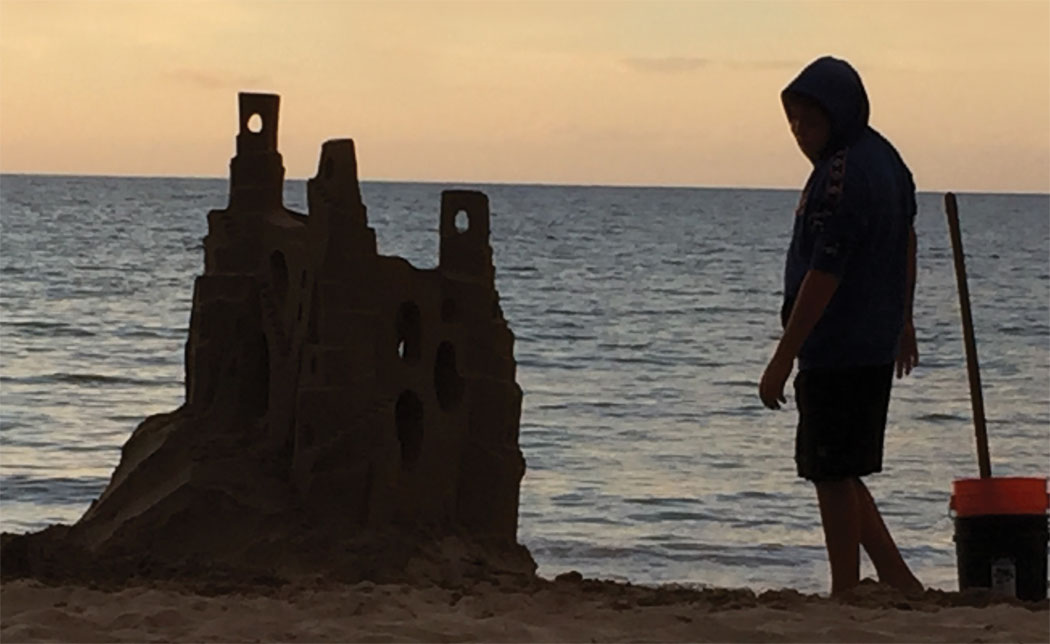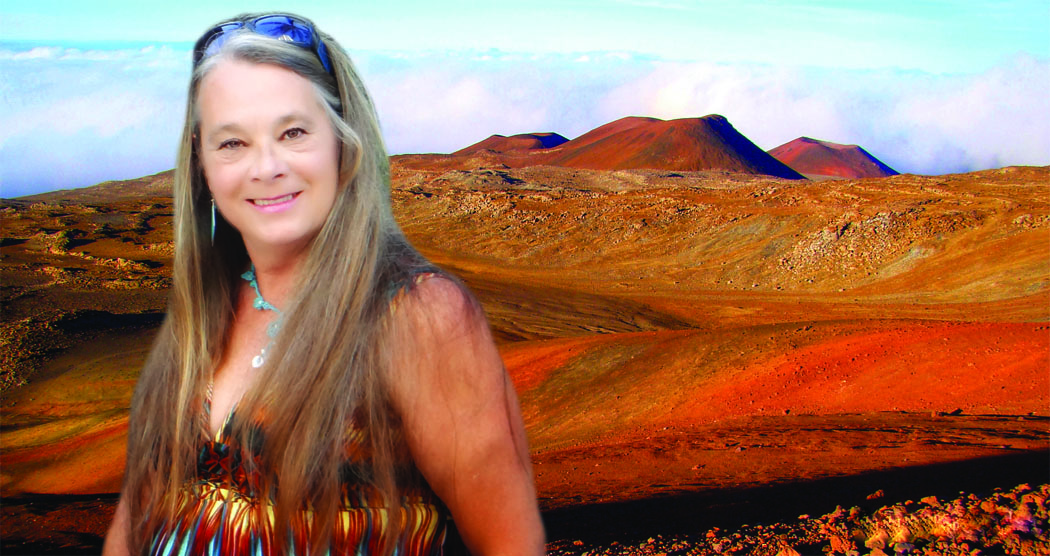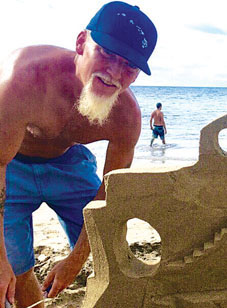
Castles in the Sand

By Catherine Tarleton
On any given day, a sunset beachgoer might take the stroll along Kauna‘oa or Mau‘umae beaches and happen upon something remarkable. Spires and staircases of sand stand in wait for some tiny mermaid; tan-khaki-taupe hibiscus and plumeria flowers bloom on the shoreline; huge letters spell “Kapu.”

The visitor pauses, taking in the work of art, soon to be eroded by the onshore wind and encroaching tide. These sculptures are the work of sand artist Mike Radtke, who dedicates many hours—and a great deal of aloha—to his creations.
“I do pretty good work I’d say, if I have to grade myself,” Mike says. Of his estimated 250 sand sculptures, he likes the complex formations best. “My favorite, or the most complex, was kind of an abstract castle,” Mike says, “It was twisted like a Dr. Seuss drawing. Two towers twisted into each other as the stairways wind into each other. It’s about six feet tall and nine feet wide.”
Living in Oregon until age two, Mike moved to Australia with his family when his father got a teaching job there. When they came back to the US, he spent time with his grandmother in Nebraska, and with his father when he was teaching in Alaska. Mike also spent time at the family property on Maui, and on O‘ahu.
“As an adult, I got to pick my own island,” Mike says, and he’s now a resident of Kapa‘au in North Kohala. “This island has the same vibe as Alaska…If I could pick anyplace on any island, it would be Kapa‘au. I have this backyard with any kind of fruit tree, and a big banyan for shade.”
Mike enjoys his Hawai‘i Island life, which he shares for 8 months of the year with his wife Nancy and their grandson. During the summer, he returns to Alaska, where he owns and operates a mom-and-pop-style grocery store and rental cabins—which he built with his son—in the remote village of Nanawaleck.
He also runs a landing craft. “The doors open onto the land, like a military amphibious vehicle,” says Mike. “The landing craft, the store and the cabins keep me busy for four months straight, then I can come back and enjoy the islands.”
Bigger Buckets
How does a 40-ish business owner, outdoorsman, dad, and husband become a sand sculptor? It all began at the beach. “My four-year-old granddaughter came to the Big Island and she wanted to build a sandcastle,” said Mike. “So I got her a sandcastle kit, with little buckets and shovels. I helped her build a sandcastle and found I had a knack for it. And I thought, ‘If I got bigger buckets, I could make bigger castles.’ So I got bigger buckets.”
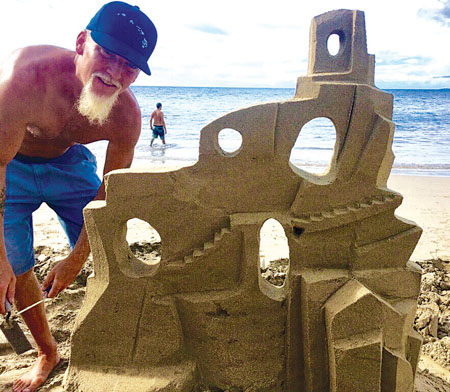
His process begins with the sand itself. Mike prefers new sand, more recently formed, uniform, and with sharper edges, like those often found in the South Kohala district. At other beaches, in Kona for example, the sand is older, more rounded at the corners, and less likely to hold together well.
Once he tried to build at Pololū. “I loved it because it was good sand and black sand,” Mike recalls. “But I didn’t have my tools, so I used a plastic spoon and a credit card!”
He doesn’t always know what he’s going to build. “I try to come to the beach with no preconception of what I’m doing to do. One time I said, ‘I’m going to do the Roman Coliseum.’ It was terrible. So, I just wing it, whatever I feel like. It depends on the sand, too. If I have really good sand, I go for it, arches everywhere. If I have a good day, it’s all because of the sand.”
Mike says that the foundation is everything. He begins any sculpture by shoveling sand and hauling water to saturate the ground at his selected spot.
“I’m really familiar with the tides. I pick my spot. I pretty much know how far the water comes,” Mike said. “I pour water from five-gallon buckets. Then I do 25 scoops of sand with a shovel. Then I pack it down with my feet. And I repeat that about four times, to make a big mound that looks kind of like a volcano…Half of the work is getting sand tall enough and big enough to do what I want to do.”
Once the foundation is laid and the mound of saturated sand is set, he begins carving. “I start at the top and work my way down,” he says. “I have a mortar tool, and an icing tool like you use for cakes, and a spoon that I use for windows, arches, and stuff like that.”
“I like to time my work to finish in the evening, five o’clock-ish, when the shadows are best,” he says. “It seems to be at its peak at that time.” But not everything always goes as planned. “Sand is so fragile. I’ll be half an hour from finishing, and the whole side will collapse,” he says. “And then when they’re three or four days old, sometimes they’re even better.”
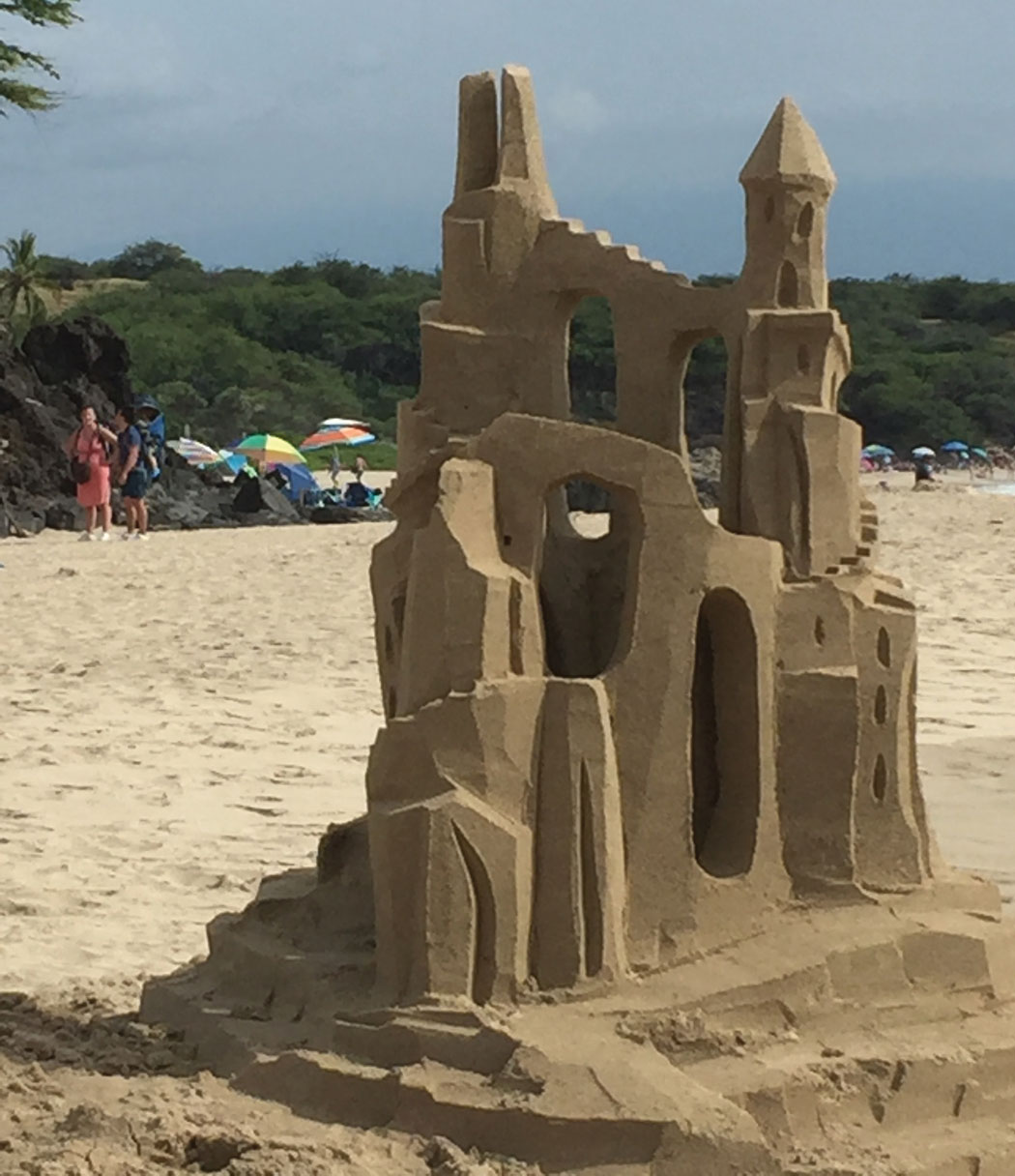
The Sands of Time
Historians claim that sand art has been practiced across many cultures and centuries. There is conjecture that ancient Egyptians built sand models of the pyramids. Sand painting (pouring colored sand or pigments on a flat surface to form a temporary image) was performed historically by Native Americans, particularly the Navajo, for healing purposes, and by Australian Aborigines. Tibetan Buddhist sand mandalas are some of the most famous sand art in the world—always destroyed after completed to demonstrate the metaphor of impermanence. In Japan, the 700-year-old craft of bonseki creates paintings by sprinkling sand on black lacquered trays, then brushing with feathers to create textures. In 14th century India, sand sculpting was a religious devotional practice.
According to sand artist/historian Lucinda Wierenga, of Atlantic City, the first profitable sand artists worked in New Jersey in the late 1890s, as pedestrians strolling along the boardwalk would toss coins into their hats. A 1901 article by Emory James discusses artist/professor Eugen Bormel who sculpted sand on the German coast near Nordeney for many years.

In the 1930s, one of Britain’s most legendary sand sculptors, Fred Darrington, began creating castles, pyramids, racehorses, and more along the beach at Weymouth. Like Mike, he always gave credit to the consistency of the sand, working with very coarse sand that bound together solidly. He too started by mixing water and sand (one pint to two pounds), laying a foundation first, then carving with a knife or lollipop stick.
Today’s sand sculptors compete in large-scale sand castle contests in numerous US states, Australia, Philippines, Europe, Canada, Peru, and Puerto Rico. An international team of artists who built a 57.94-foot-tall sandcastle in Germany in June 2019 holds the Guinness World Record for sand sculpture.
A Style of His Own
Mike doesn’t compete or go for records. For him, sand sculpting is something he does for himself, and for the experience.
“I love going to the beach, I love being in the sun, I love taking care of my body,” Mike says. “Unintentionally, my work gets a big response and people take pictures.”

Mike focuses on original creations. He doesn’t watch television, so is often surprised when people ask if that’s the castle from Game of Thrones, for example. And, he says he doesn’t have a particular style, or an artist he tries to emulate. His art, however, has been compared to Dutch graphic artist M.C. Escher, whose complex drawings often featured intertwining staircases and walkways. Another artist people mention is Spanish architect Antoni Gaudi. Eclectic, frequently intricate and fanciful, seven of Gaudi’s works have been listed as UNESCO World Heritage Sites. “Just to be mentioned with them in the same breath is a huge compliment,” Mike said.
“Sometimes I do Hawaiian words, like ‘kapu,’” he elaborates. “Tourists ask what it means and it leads to a conversation. Like, ‘Kapu, what does that mean?’ I tell them it has different meanings, but in this case, it means sacred, because to me, Mau‘umae is a sacred beach.”
One day a mindfulness teacher told Mike that his artwork is a form of mindfulness. Serendipitously, he met Nancy that same day, on that same beach, and told her what happened. “She said, ‘Oh my God, I’ve read all of his books. Can you get his autograph?’ I said, ‘Maybe we’ll invite him for supper.’” Nancy is also an artist. “My wife is Native Alaskan. Her master’s thesis was about how Native Alaskans have been practicing mindfulness since the beginning of time.”
As the sun goes down, Mike may take a moment to breathe and admire the work of the day. Perhaps someone strolls by for a closer look, a photo, or a conversation. Perhaps he’s the only one to see it, or maybe there will be remnants when he comes back. “I finish a sculpture and walk away,” Mike says. “I know a kid could squish it, a bird could land on it, a wave can take it, and that’s fine as long as it doesn’t happen right before my eyes.”
To see Mike’s one-of-a-kind art in person, you’ll need to find it on the beach! ❖
